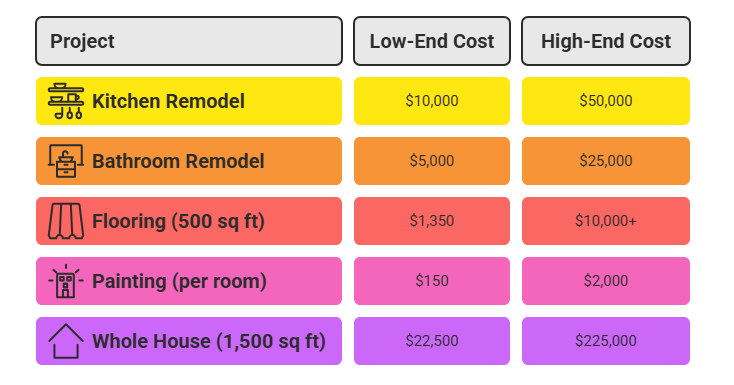How Do I Estimate the Cost of a Home Renovation?
June 10, 2025
2 minutes read
Renovation Cost

How Do I Estimate the Cost of a Home Renovation?
Renovation Cost
June 10, 2025
2 minutes read
Step 1: Define the Scope of Your Renovation
Know exactly what you’re tackling before you crunch a single number.
- Which rooms? (Kitchen? Bathroom? Whole house?)
- What kind of upgrades? (Cosmetic refreshes, structural changes, new appliances?) 🔍 Pro tip: A clear vision = a clearer budget.
Step 2: Research Average Costs
Get your expectations in line with reality.
- Whole-house renovations (1,250–1,600 sq. ft.): Average around $52,000
- Typical project ranges:
- Kitchen: $10,000–$50,000
- Bathroom: $5,000–$25,000
- Flooring (500 sq. ft.): $1,350–$10,000+
- Painting: $150–$2,000 per room
📚 Sources: Rocket Mortgage, This Old House, Angi, and more.
Step 3: Estimate Costs by Square Foot
Shortcut: multiply your renovation area by a price-per-square-foot benchmark.
- Basic updates: $15/sq. ft.
- Mid-range remodels: $60/sq. ft.
- High-end, luxury changes: $150+/sq. ft.
📏 Example: Redoing a 500 sq. ft. basement? Budget $7,500–$30,000 depending on finishes.
Step 4: Factor in Key Cost Drivers
Hidden costs can break your budget—plan for them early.
- Labor: 10–20% of your total project cost
- Materials and finishes: Premium options = premium prices
- Permits and inspections: Mandatory (and region-dependent)
- Age and condition of home: Older = more surprises, aka more $$$
Step 5: Get Quotes from Professionals
DIY estimates are good. Pro quotes are better.
- Provide a detailed project scope to contractors and designers.
- Get at least 3–5 quotes to compare pricing and services. 💬 Watch for: Major discrepancies (hint: they’re a red flag).
Step 6: Use Tech Tools and Templates
Let spreadsheets and apps do the heavy lifting.
- Top tools:
- Renovation Budget Tracker
- Home Improvement Planner
- Microsoft Excel/Google Sheets templates
- Why use them? Easy organization, real-time updates, no surprises.
Step 7: Plan for Contingencies
Spoiler: unexpected costs are inevitable.
- Pad your budget with an extra 10–20% buffer for the "uh-oh" moments.
🚨 Translation: If you plan to spend $50,000, earmark an extra $5,000–$10,000 just in case.
Quick Example: Cost Breakdown Table

Tips for an Accurate Estimate
✔️ Use multiple methods (square foot + quotes + comparables) ✔️ Track expenses obsessively—even the small ones add up ✔️ Update your budget as changes arise
FAQ: Your Home Renovation Cost Questions, Answered
Q1: What’s the fastest way to get a ballpark renovation estimate? A: Multiply your project’s square footage by an average cost-per-square-foot number based on project complexity.
Q2: How much should I budget for unexpected issues? A: Always set aside 10–20% of your total project cost for contingency expenses.
Q3: Are online renovation calculators accurate? A: They're great for rough estimates but should always be backed up with professional quotes for precision.
Q4: Does the age of my house affect renovation costs? A: Absolutely. Older homes often come with hidden repair needs—think outdated wiring, plumbing, or structural surprises.
Q5: What’s the best free tool to help me budget a home renovation? A: Try Google Sheets with a free renovation budget template—or check out apps like Renovation Budget Tracker.
Final Word: Estimating the cost of your home renovation doesn’t have to be guesswork. A clear plan, real numbers, and a little buffer room will have you swinging the hammer without sweating the final bill.